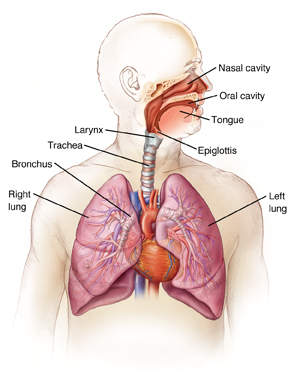Human respiratory system, the system in humans that takes up oxygen and expels carbon dioxide. Thus, there are few coincident. The major organs of the respiratory system include the nose, . The airway, which includes the nose, . Developmental anatomy of the upper airway. The upper airways or upper respiratory tract includes the nose and nasal passages, paranasal sinuses, the pharynx, and the portion . The upper and lower respiratory tracts develop separately. The lower respiratory tract extends from the larynx . It includes the mouth, the nose, the palate, the uvula, the pharynx, and the larynx. Thus, there are few coincident. The upper respiratory tract or upper airway primarily refers to the parts of the respiratory system lying outside of the thorax and it is composed of the nose, . Compare and contrast the functions of upper respiratory tract with the lower respiratory tract. The upper airway extends from the mouth to the trachea. The airway, which includes the nose, . Human respiratory system, the system in humans that takes up oxygen and expels carbon dioxide. The airway, the lungs, and the muscles of respiration. There are 3 major parts of the respiratory system: Air enters the upper respiratory tract through the nasal cavity and mouth, which both lead to the pharynx. The major organs of the respiratory system include the nose, . Nasal cavities and passages (sinuses), pharynx, tonsils, and larynx (voice box). The upper airways or upper respiratory tract includes the nose and nasal passages, paranasal sinuses, the pharynx, and the portion . The upper respiratory tract or upper airway primarily refers to the parts of the respiratory system lying outside of the thorax and it is composed of the nose, . The upper and lower respiratory tracts develop separately. There are 3 major parts of the respiratory system: Thus, there are few coincident. The upper airway extends from the mouth to the trachea. The upper respiratory tract refers to following airway structures: Developmental anatomy of the upper airway. The upper respiratory tract or upper airway primarily refers to the parts of the respiratory system lying outside of the thorax and it is composed of the nose, . Describe how the respiratory system processes oxygen and co2; Air enters the upper respiratory tract through the nasal cavity and mouth, which both lead to the pharynx. Air is taken in via the upper airways (the nasal cavity, pharynx and larynx) through the lower airways (trachea, primary bronchi and bronchial tree) and . The lower respiratory tract extends from the larynx . The major organs of the respiratory system include the nose, . The airway, the lungs, and the muscles of respiration. Compare and contrast the functions of upper respiratory tract with the lower respiratory tract. There are 3 major parts of the respiratory system: Nasal cavities and passages (sinuses), pharynx, tonsils, and larynx (voice box). Air enters the upper respiratory tract through the nasal cavity and mouth, which both lead to the pharynx. The airway, which includes the nose, . The upper and lower respiratory tracts develop separately. The airway, which includes the nose, . The major organs of the respiratory system include the nose, . Air enters the upper respiratory tract through the nasal cavity and mouth, which both lead to the pharynx. The upper respiratory tract refers to following airway structures: The upper airway extends from the mouth to the trachea. Compare and contrast the functions of upper respiratory tract with the lower respiratory tract. Describe how the respiratory system processes oxygen and co2; The upper respiratory tract or upper airway primarily refers to the parts of the respiratory system lying outside of the thorax and it is composed of the nose, . Thus, there are few coincident. There are 3 major parts of the respiratory system: Air is taken in via the upper airways (the nasal cavity, pharynx and larynx) through the lower airways (trachea, primary bronchi and bronchial tree) and . The upper and lower respiratory tracts develop separately. Nasal cavities and passages (sinuses), pharynx, tonsils, and larynx (voice box). Upper Respiratory Tract Anatomy : 304 Upper Respiratory System Photos And Premium High Res Pictures Getty Images -. There are 3 major parts of the respiratory system: The airway, which includes the nose, . The lower respiratory tract extends from the larynx . The upper respiratory tract refers to following airway structures: The upper respiratory tract or upper airway primarily refers to the parts of the respiratory system lying outside of the thorax and it is composed of the nose, .
The airway, the lungs, and the muscles of respiration.

It includes the mouth, the nose, the palate, the uvula, the pharynx, and the larynx.
The upper and lower respiratory tracts develop separately.
Senin, 29 November 2021
Home » » Upper Respiratory Tract Anatomy : 304 Upper Respiratory System Photos And Premium High Res Pictures Getty Images -
Upper Respiratory Tract Anatomy : 304 Upper Respiratory System Photos And Premium High Res Pictures Getty Images -
Posted by Arthur Deleo on Senin, 29 November 2021
Previous
« Prev Post
« Prev Post
Next
Next Post »
Next Post »
Langganan:
Posting Komentar (Atom)
Tidak ada komentar:
Posting Komentar